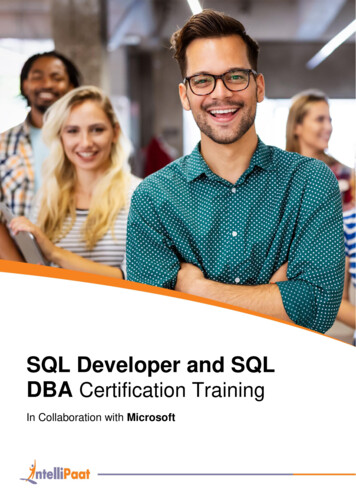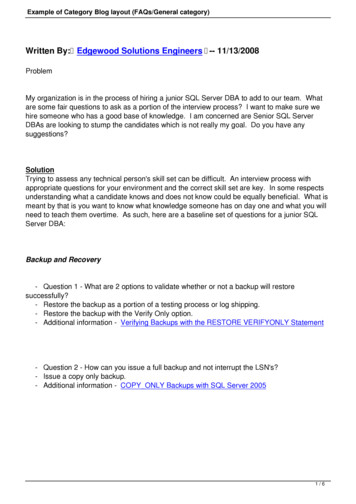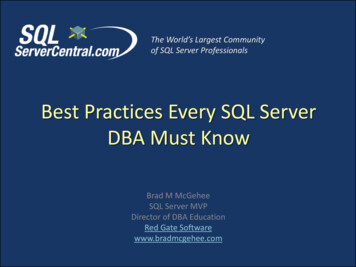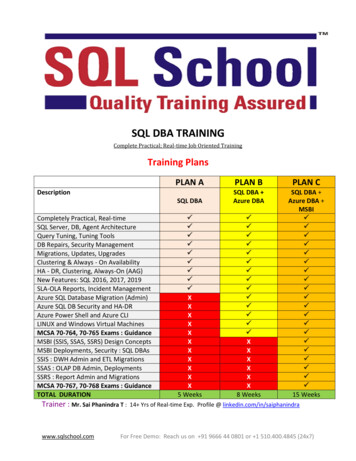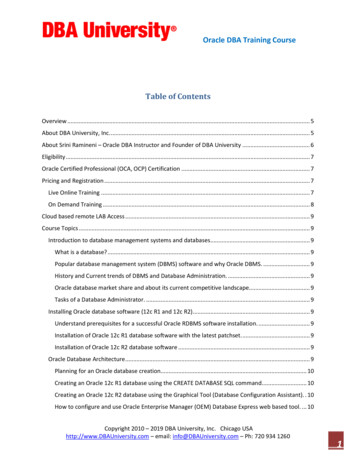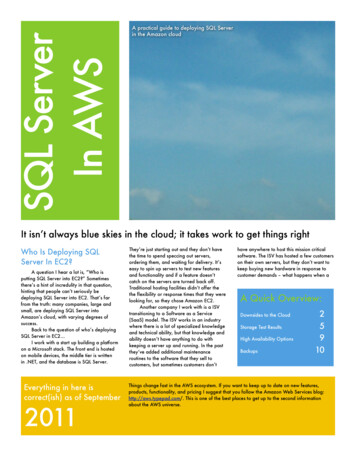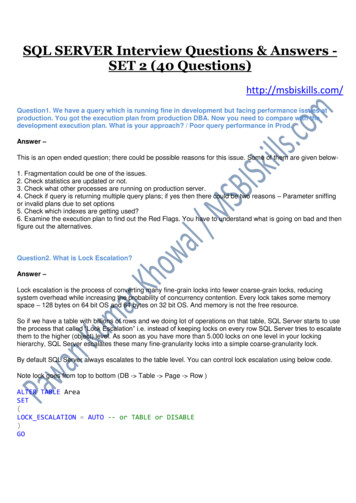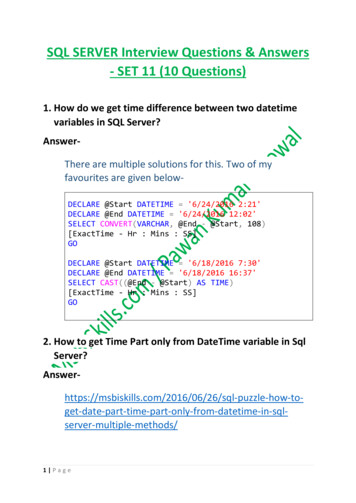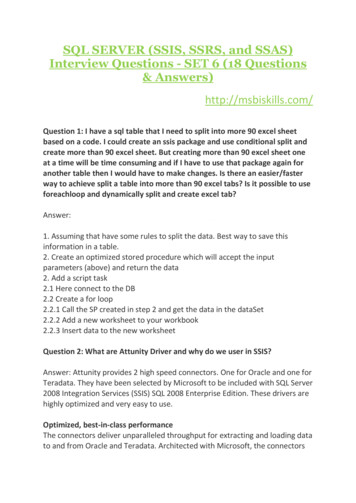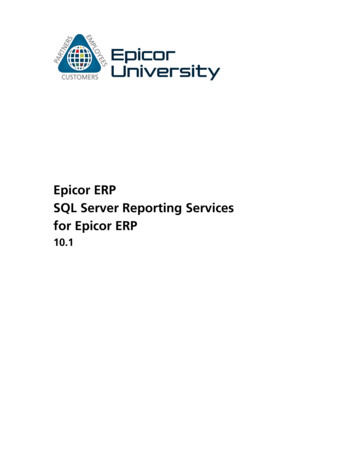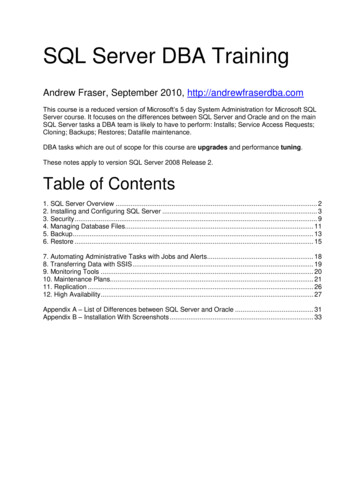
Transcription
SQL Server DBA TrainingAndrew Fraser, September 2010, http://andrewfraserdba.comThis course is a reduced version of Microsoft‟s 5 day System Administration for Microsoft SQLServer course. It focuses on the differences between SQL Server and Oracle and on the mainSQL Server tasks a DBA team is likely to have to perform: Installs; Service Access Requests;Cloning; Backups; Restores; Datafile maintenance.DBA tasks which are out of scope for this course are upgrades and performance tuning.These notes apply to version SQL Server 2008 Release 2.Table of Contents1. SQL Server Overview . 22. Installing and Configuring SQL Server . 33. Security . 94. Managing Database Files. 115. Backup . 136. Restore . 157. Automating Administrative Tasks with Jobs and Alerts . 188. Transferring Data with SSIS . 199. Monitoring Tools . 2010. Maintenance Plans. 2111. Replication . 2612. High Availability . 27Appendix A – List of Differences between SQL Server and Oracle . 31Appendix B – Installation With Screenshots . 33
SQL Server DBA Training1. SQL Server OverviewSQL Server was originally the Microsoft rebadged version of the Sybase relational database. Itis only available on Windows platforms. Current version (July 2010) is SQL Server 2008 R2.The two principal differences between SQL Server/Sybase and Oracle are:1. SQL Server has no undo or rollback segments and therefore no rollback/commitfunctionality, or read consistent data views; other than what little can be accommodatedfrom the on line redo logs.2. SQL Server architecture is: 1 host machine to 1 or more Instances to many Databases.There is no such thing as a tablespace within SQL Server. On line redo logs exist atdatabase level.A more complete list of differences is given in Appendix B.SQL Server does not offer an equivalent to RAC. There are SQL Server equivalents todataguard and replication, and SQL Server does offer database mirroring and failoverclustering.Note that SQL commands are not executed by ; or / as in oracle, but with go.SQL Server is mostly managed from the SQL Server Management Studio (similar to OracleEnterprise Manager – and was called Enterprise Manager in older versions).The exception is the optional components (below) are instead managed from the SQL ServerBusiness Intelligence Development Studio (which is a cut-down version of Microsoft VisualStudio).Stopping and Starting SQL Server is done with SQL Server Configuration Manager (Start AllPrograms Microsoft SQL Server 2008 R2 Configuration) or, less correctly, services.msc.SQL Server has optional components which come at no extra cost (if hosted on samemachine): SQL Server Reporting Services – Business Intelligence reporting, Microsoft‟s alternativeto OBIEE, Discoverer, Crystal Reports. Has very good integration with Microsoft clientproducts such as Excel which is a significant for end-user usability. Analysis Services – OLAP (on line analytical processing), cubes, data mining. SQL Server Integration Services – ETL (extract transform load) and export/import tools. Isequivalent to export/import, data pump, sql loader, DBA shell scripts. This was called DTS(Data Transformation Services) in older versions.Version History:NameSybaseSQL Server 6.5SQL Server 7SQL Server 2000SQL Server 2005SQL Server 2008SQL Server 2008 Release 2Number6.57.08.09.010.010.5Release Date199619982000200520082010Page 2 of 48
SQL Server DBA Training2. Installing and Configuring SQLServerInstallationUnlike Oracle, Microsoft do not make their software available for download. It is insteadtypically supplied in a pack of Microsoft DVDs with licence codes preloaded. In mostorganisations these DVDs are controlled by the Windows Sys Admin team – it is often a goodidea to keep a of copy the SQL Server installation software to a secure network share. DBAsService packs (patchsets) are made available for download on microsoft.com/sqlserver, withoutthe need for support login credentials in contrast to oracle patchsets.2.1 Which Edition do I Install?SQL Server comes in many more editions than Oracle does, although it does avoid Oracle‟slong list of extra cost options.A common practice for a mixed Oracle/SQL Server site to adopt would be: Express Edition – for desktop PCs, dev/test servers, small production servers. Standard Edition – for all other systems. Enterprise Edition – not used – instead host systems that large in Oracle.Two free versions of SQL Server are available for download at Microsoft.com/sql180 day trial/evaluation edition – fully functional, until the end of the time period when it willstop running altogether and display this message: “Evaluation period has expired. Forinformation on how to upgrade your evaluation software please go tohttp://www.microsoft.com/sql/howtobuy (http://www.microsoft.com/sql/howtobuy)”Express edition – Has most functionality except is limited to 10gb of data and the use a singleCPU and 1gb of RAM. CPU here means a physical CPU – multiple cores are ok. Unlike oracleexpress edition, service packs are made available. This can often be a good option for dev/test,and even for small production databases.Express Edition has a number of technical restrictions which make it undesirable for large-scaledeployments, including: maximum database size of 4 GB per database (2005 version) or 10 GB (2008 and 2008R2 versions) (compared to 2 GB in the former MSDE). The limit applies per database(log files excluded); but in some scenarios users can access more data through the useof multiple interconnected databases. hardware-utilization limits:o Single physical CPU, multiple coreso 1 GB of RAM (runs on any size RAM system, but uses only 1 GB) absence of the SQL Server Agent serviceAlthough its predecessor, MSDE, generally lacked basic GUI management tools, SQL ServerExpress includes several GUI tools for database management. These include: SQL Server Management Studio Express SQL Server Configuration Manager SQL Server Surface Area Configuration tool SQL Server Business Intelligence Development Studio.Page 3 of 48
SQL Server DBA TrainingFeatures available in SQL Server "Standard" and better editions but absent from SQL ServerExpress include (for example): Analysis Services Integration Services Notification ServicesThe below variants of Express edition install are available for download. The DBAs life is madeeasier if the management studio is installed along with the database.For both trial and express editions, it is possible to upgrade to a licensed edition with a validlicense code.For SQL Server 2005 this required setting a command line parameter (“setup.exeSKUUPGRADE 1”), but that requirement has been removed with SQL Server 2008.Licensed Editions – Standard Edition and Enterprise EditionIn contrast to oracle environments, standard edition is much more commonly used thanenterprise edition.Standard Edition is limited to 4 CPUs. It will install on machines with more CPUs, but will notmake use of the extra CPUs. With that exception, and unlike oracle standard edition, it hasalmost all of the features of enterprise edition, including failover clustering, replication, databasemirroring. 4 CPUs here means 4 physical CPUs – potentially many more than 4 cores.Enterprise Edition has no CPU limitation. Partitioning and indexed views are only available withEnterprise Edition. Snapshot and Transactional replication for Oracle are also only availablewith Enterprise Edition. Those are all features associated with data warehouses. Backupcompression is also Enterprise Edition s/editions-compare.aspx)Enterprise edition licenses cost four times the price of standard edition en/us/pricing.aspx)Page 4 of 48
SQL Server DBA TrainingNote that on virtual servers, each Standard Edition virtual processor is licensed as if it was aphysical processor. This makes virtual servers very expensive, and unnecessarily so, since thedifferent databases could just be hosted as separate databases in a single physical SQL Serverinstance. SQL Server Enterprise Edition however allows virtual servers to run for free on top ofa licensed physical server. Another option for a virtual environment would be to pay for ClientUser Access Licensing instead of Processor Licensing.Multicore processors are treated as a single processor for licensing purposes, unlike withOracle which applies a multiplying factor.Passive DR servers, such as for database mirroring or failover clustering, do not requirelicensing.Supported Operating Systems: Windows Server 2008 Windows Server 2003 XP, Vista, Windows 72.2 InstallationServer buildIf possible, use 64 bit Windows Server 2008 with latest operating system service packs applied.Normally executable program files will be installed into C: drive, while database files would bekept on SAN storage mapped as a D: drive. For critical high performance databases, anadditional SAN array would be used (mapped as E: drive) to separate data files fromtransaction log files.You require local admin rights for the install, but you do not need any special domain rights.InstallationCarry out all the following in a temporary directory (like c:\junk) that you can delete once theinstallation is complete.Copy software from network share or DVD (licensed versions) or download (free versions) intoa in a temporary directory (like c:\junk) that should be deleted once the installation is complete.Extract if required and run setup.exe.Install pre-requisites if required (especially likely on older versions of operating system, such asWindows Server 2003 rather than Windows Server 2008), in this case .net version 3.5.Planning screen: The “system configuration checker” is run when you start the install, but youcan choose to run it from the planning screen firstInstallation screen:Page 5 of 48
SQL Server DBA TrainingClustering options are here. Otherwise top option will run the “system configurationchecker/setup support rules” even if you just ran that earlier.Different from oracle – need to enter product (license) key to get a licensed installation. That isoften coded into the software shipped in DVD packs.Feature Selection – Normally I would not install analysis services and reporting servicesunless they are specifically required on this host machine. I would install everything else. BooksOnline (the documentation) is all freely available on the internet now so some DBAs choose notinstall it here.Main components are Database Engine Analysis Services OLAP, Data Mining Reporting Services interactive, tabular, graphical, or free-form reports. Integrates withExcel and Sharepoint. Like Discoverer, OBIEE, Crystal Reports. Integration Services ETL, workflowOlder versions (SQL Server 2005 and earlier) required an IIS install for reporting services.It is good practice to have only one instance of SQL Server on a host machine. In that case, usethe default name for your instance. However, if you are for some reason going to have severalinstances, it is best to name all of them and not have any using the default name.Service accounts1) SQL Server database engine domain\sql service The database process itself, likeoracle processes pmon, smon, etc. domain\sql service should be a domain user account withno/minimal domain-level privileges, but with substantial privileges on the local host machine.You can assign NT Authority\system (the local system account like root) to run SQL Serverdatabase engine service, but that will prevent easy connections between databases such as forreplication.2) SQL Server Agent NT Authority\network service The service that executes jobs,monitors, SQL Server, and allows automation of administrative tasks. This is like cron – if this isnot running, automated/scheduled jobs will not run.Make sure SQL Server Agent is set to start automatically.3) All others (if any) NT Authority\local service (minimal privileges like user „nobody‟)Page 6 of 48
SQL Server DBA TrainingAn exception to this is with a failover cluster, where the preference is to use domain accountsthroughout.For failover cluster configurations, use the domain user account for SQL Server service, andmake the start up type set to manual. Windows Clustering itself handles startup of services atfailover time.Collation – keep at default unless e.g. vendor insists otherwise. Best if possible to have alldatabases inside an organisation use same collation set.Note that this sets the default collation for the instance – individual databases can be chosen tocreate with a different collation.You can control collation in individual SQL statements:select * from mytable COLLATE Latin1 General CS ASgoAccount provisioningMixed mode allows username/password accounts so is less secure. Windows authenticationmode is restricted to active directory domain accounts and local host server Windows useraccounts. Keep to Windows authentication mode only unless required by e.g. software vendorto allow username/password access.This setting can be changed afterwards easily, although requires an instance bounce forchange to take effect.If choosing mixed mode, the “sa” (system admin like „sys‟) password needs specified. It isgood practice to disable this account.You can add the dba active directory domain group as a SQL Server administrator, rather thanadding individual users. That way team members joining or leaving will automatically haveadministrator privileges as they are added into the dba active directory domain group, withoutthe need to change anything on individual servers and instances.Data Directories * Important*This is easy to miss as it is in a tab that is not displayed by default. The data root directoryshould be changed to point to SAN storage rather than internal C: drive. This determines wheredatafiles and transaction log files will be stored by default. This is the only path change fromdefault needed during the installation.The default data directory location can easily be changed afterwards, but that will not fix thesystem databases that are created already at install time.Page 7 of 48
SQL Server DBA TrainingFilestream storage is only used if you are going to have a huge amount of BLOB data and wishto store it outside the database in a filesystems, so in most cases leave this uncheckedLab 1.1 – Install SQL Server1.4 Service Packs for SQL ServerService Packs (Microsoft‟s name for patchsets) are simple to install. Download the service pack executable file from microsoft.com/sql onto the target machine.No login credentials are required to access the download. Run the downloaded service pack executable file.They do not have to be installed one after the other – so Service Pack 4 already contains all ofservice packs 1, 2, and 3. It is good practice to immediately apply the latest service pack to anew SQL Server before creating the user databases and loading data.The service pack level of a SQL Server can be worked out by taking the value of Version (rightclick instance, properties). A table of product version numbers to Service Packs is available atmicrosoft.com. Primary version numbers are numbered rather than following year notation –SQL Server v6.5, v7, v8 2000, v9 2005, v10 2008, v10.5 2008R2.SQL Server 2008 R2 had no service pack released as of September 2010.1.6 Post InstallationPage 8 of 48
SQL Server DBA TrainingServices can be viewed, modified, stopped, and started in the Computer Management Console.Right click my computer, choose manage, expand SQL Server Configuration Manager.(Alternatively, “Start” “Run” “services.msc”)The SQL Server part only is also available through “Start” “Programs” “Microsoft SQLServer 2008 R2” “Configuration Tools” “SQL Server configuration Manager”Lab 1.2 – Modify, stop, start services1.7 Remote AdministrationSQL Server is most easily controlled from a desktop PC. Each Server can be added to the list(registered) within SQL Server Management Studio, then fully controlled from the desktop.Once a server is registered, it can then be administered from the desktop SQL ServerManagement Studio just as if it was running on the desktop machine itself.Registered servers can be grouped together within Management Studio.Lab 1.3 – Open SQL Server Management Studio, view the system databases, create a newdatabase.ORLab 1.3 – run AdventureWorks2008R2 RTM.exe to install sample databases, open SQL ServerManagement Studio, open a table for editing.3. Security3.1 Logins and UsersTwo separate security accounts exist in SQL Server, rather than the single username in oracle:1. Logins – A login account is for an entire instance.2. Users – A user account is for a particular database within an instanceAccounts must have both a login account for the instance and a user account for a database orthey will not be able to connect.In addition there are Windows accounts, typically handled through multi-server domains andmaintained by system administrators rather than DBAs.Page 9 of 48
SQL Server DBA TrainingThere are two methods of authentication for logins: Windows authentication (equivalent to anops login in oracle) and mixed mode authentication, which is a username/password separatefrom the operating system.Service access requests would involve four stages:1. Create login account2. Create user account – one for each database for which access is required3. Assign login account to above user accounts4. Assign permissions and roles to the above user accountsAlthough the whole process is simplified by using the wizards.The sa login is the system administrator – equivalent to sys in oracle. It should not be usedoutside the DBA team. It often has its login rights disabled for security.The guest account also is often dropped for security reasons.Lab 3.1 – add then revoke logins and users.Prior to SQL Server 2008 Release 2, accounts which had Windows local admin rights on aserver (similar to sudo root rights in linux) also had SQL Server system admin rights login. Thathas been changed with SQL Server 2008 Release 2, so that these accounts cannot now evenconnect to SQL Server unless explicitly granted login rights.3.2 Permissions and RolesRoles exist in SQL Server as in oracle. Roles are either Server level or Database level.There are 7 fixed server level roles (sysadmin; dbcreator; diskadmin; processadmin;serveradmin; setupadmin; securityadmin, bulkadmin), 9 Fixed Database roles, and as manyUser-defined Database roles as you want to create.The sysadmin server level role has DBA privileges, and so should not be granted outside theDBA t
SQL Server DBA Training Page 3 of 48 2. Installing and Configuring SQL Server Installation Unlike Oracle, Microsoft do not make their software available for download. It is instead typically supplied

